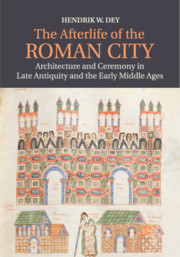Crossref Citations
This Book has been
cited by the following publications. This list is generated based on data provided by Crossref.
Husár, Martin
2017.
Processions and architecture of Papal Rome in relation to the stay of the Salonica brothers in Rome.
Graeco-Latina Brunensia,
p.
93.
Castiglia, Gabriele
2018.
TOPOGRAFIA CRISTIANA DELLATUSCIA ANNONARIAE DELLATUSCIA LANGOBARDORUM(IV-VIII SEC. D.C.).
Papers of the British School at Rome,
Vol. 86,
Issue. ,
p.
85.
Poveda Arias, Pablo
2019.
La diócesis episcopal en la Hispania visigoda: concepción, construcción y disputas por su territorio.
Hispania Sacra,
Vol. 71,
Issue. 143,
p.
9.
WELTON, MEGAN
2020.
THE CITY SPEAKS: CITIES, CITIZENS, AND CIVIC DISCOURSE IN LATE ANTIQUITY AND THE EARLY MIDDLE AGES.
Traditio,
Vol. 75,
Issue. ,
p.
1.
Zavagno, Luca
2021.
The Byzantine City from Heraclius to the Fourth Crusade, 610–1204.
p.
29.
Zavagno, Luca
2021.
The Byzantine City from Heraclius to the Fourth Crusade, 610–1204.
p.
83.
Zavagno, Luca
2021.
The Byzantine City from Heraclius to the Fourth Crusade, 610–1204.
p.
1.
Zavagno, Luca
2023.
“The Navigators”. Mediterranean Cities and Urban Spaces in the Passage from Late Antiquity to the Early Middle Ages (ca. 600 – ca. 850 CE).
Studia Ceranea,
Vol. 13,
Issue. ,
p.
165.
Antonio, Margaret L
Weiß, Clemens L
Gao, Ziyue
Sawyer, Susanna
Oberreiter, Victoria
Moots, Hannah M
Spence, Jeffrey P
Cheronet, Olivia
Zagorc, Brina
Praxmarer, Elisa
Özdoğan, Kadir Toykan
Demetz, Lea
Gelabert, Pere
Fernandes, Daniel
Lucci, Michaela
Alihodžić, Timka
Amrani, Selma
Avetisyan, Pavel
Baillif-Ducros, Christèle
Bedić, Željka
Bertrand, Audrey
Bilić, Maja
Bondioli, Luca
Borówka, Paulina
Botte, Emmanuel
Burmaz, Josip
Bužanić, Domagoj
Candilio, Francesca
Cvetko, Mirna
De Angelis, Daniela
Drnić, Ivan
Elschek, Kristián
Fantar, Mounir
Gaspari, Andrej
Gasperetti, Gabriella
Genchi, Francesco
Golubović, Snežana
Hukeľová, Zuzana
Jankauskas, Rimantas
Vučković, Kristina Jelinčić
Jeremić, Gordana
Kaić, Iva
Kazek, Kevin
Khachatryan, Hamazasp
Khudaverdyan, Anahit
Kirchengast, Sylvia
Korać, Miomir
Kozlowski, Valérie
Krošláková, Mária
Kušan Špalj, Dora
La Pastina, Francesco
Laguardia, Marie
Legrand, Sandra
Leleković, Tino
Leskovar, Tamara
Lorkiewicz, Wiesław
Los, Dženi
Silva, Ana Maria
Masaryk, Rene
Matijević, Vinka
Cherifi, Yahia Mehdi Seddik
Meyer, Nicolas
Mikić, Ilija
Miladinović-Radmilović, Nataša
Milošević Zakić, Branka
Nacouzi, Lina
Natuniewicz-Sekuła, Magdalena
Nava, Alessia
Neugebauer-Maresch, Christine
Nováček, Jan
Osterholtz, Anna
Paige, Julianne
Paraman, Lujana
Pieri, Dominique
Pieta, Karol
Pop-Lazić, Stefan
Ruttkay, Matej
Sanader, Mirjana
Sołtysiak, Arkadiusz
Sperduti, Alessandra
Stankovic Pesterac, Tijana
Teschler-Nicola, Maria
Teul, Iwona
Tončinić, Domagoj
Trapp, Julien
Vulović, Dragana
Waliszewski, Tomasz
Walter, Diethard
Živanović, Miloš
Filah, Mohamed el Mostefa
Čaušević-Bully, Morana
Šlaus, Mario
Borić, Dušan
Novak, Mario
Coppa, Alfredo
Pinhasi, Ron
and
Pritchard, Jonathan K
2024.
Stable population structure in Europe since the Iron Age, despite high mobility.
eLife,
Vol. 13,
Issue. ,





